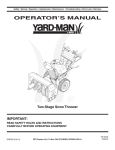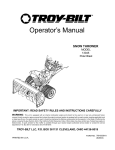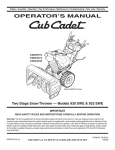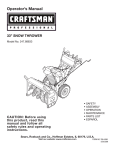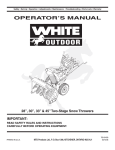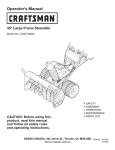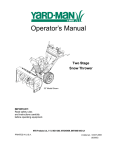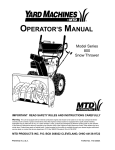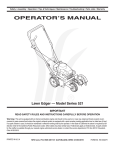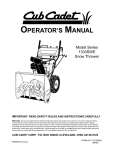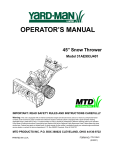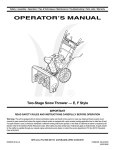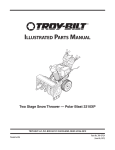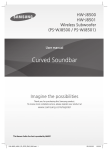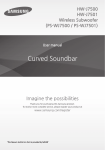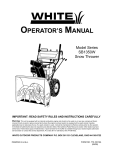Download Troy-Bilt 31AH9Q77766 Snow Blower User Manual
Transcript
Safety • Assembly • Operation • Tips & Techniques • Maintenance • Troubleshooting • Parts Lists • Warranty OPERATOR’S MANUAL Two-Stage Snow Thrower – Storm 13045 31AH9Q77766 IMPORTANT READ SAFETY RULES AND INSTRUCTIONS CAREFULLY BEFORE OPERATION Warning: This unit is equipped with an internal combustion engine and should not be used on or near any uniiproved forest-covered, brushcovered or grass-covered land unless the engine’s exhaust system is equipped with a spark arrester meeting applicable local or state laws (if any). If a spark arrester is used, it should be maintained in effective working order by the operator. In the State of California the above is required by law (Section 4442 of the California Public Resources Code). Other states may have similar laws. Federal laws apply on federal lands. A spark arrester for the muffler is available through your nearest engine authorized service dealer or contact the service department, P.O. Box 361131 Cleveland, Ohio 44136-0019. PRINTED IN U.S.A FORM NO. 769-00381C 6/28/06 This Operator’s Manual is an important part of your new snow thrower. It will help you assemble, prepare and maintain the unit for best performance. Please read and understand what it says. Table of Contents Customer Support............................................... 2 Safety Labels....................................................... 3 Safe Operation Practices.................................... 4 Setting Up Your Snow Thrower........................... 6 Operating Your Snow Thrower.......................... 10 Making Adjustments......................................... 14 Maintaining Your Snow Thrower....................... 16 Off-Season Storage........................................... 22 Troubleshooting................................................. 23 Illustrated Parts List.......................................... 24 Warranty............................................................. 31 Specifications are subject to change without notification or obligation. Images may not reflect your exact model and are for reference purposes only. Finding and Recording Model Number BEFORE ASSEMBLING YOUR NEW EQUIPMENT: Please locate the model plate on the equipment and copy the information to the sample model plate provided to the right. You can locate the model plate by standing at the operating position and looking down at the rear of the snow thrower. This information will be necessary to use the manufacturer’s web site, when contacting the Customer Service Department, or when obtaining assistance from an authorized Troy-Bilt service dealer. www.troybilt.com TROY-BILT LLC P. O. BOX 3 6 1 1 3 1 CLEVELAND, OH 44136 330-558-7220 866-840-6483 Customer Support Please do not return the unit to the retailer from which it was purchased, without first contacting Customer Support. If you have difficulty assembling this product or have any questions regarding the controls, operation, or maintenance of this unit, you can seek help from the experts. Choose from the options below: • Visit www.troybilt.com for many useful suggestions. Click • The engine manufacturer is responsible for all enginethe Tool Bench tab to access the Troy-Bilt Solution Center. related issues with regard to performance, power-rating, specifications, warranty, and service. Please refer to the • Call a Customer Support Representative at engine manufacturer’s Owner’s/Operator’s Manual, packed 1-866-840-6483. separately with your unit, for more information. $!.'%2 +%%0!7!9&2/-2/4!4).')-0%,,%2 !.$!5'%2#/.4!#47)4()-0%,,%2/2 !5'%2#!.!-054!4%(!.$3!.$&%%4 53%#,%!./544//,4/5.#,/' $)3#(!2'%#(54% $)3%.'!'%#,54#(,%6%2334/0%.').% !.$2%-!)."%().$(!.$,%35.4),!,, -/6).'0!243(!6%34/00%$"%&/2% 5.#,/'').'/23%26)#).'-!#().% 4/!6/)$4(2/7./"*%#43).*52)%3 .%6%2$)2%#4$)3#(!2'%!4"934!.$%23 53%%842!#!54)/.7(%./0%2!4).'/. '2!6%,352&!#%3 2%!$/0%2!4/2g3-!.5!, #,%!./544//, $!.'%2 1 Safety Labels !6/)$).*529&2/2/4!4).'!5'%2 +%%0(!.$3&%%4 !.$#,/4().'!7!9 $!.'%2 .%6%2054(!.$).#(54%#/.4!#47)4( 2/4!4).'0!243#!.!-054!4%&).'%23 !.$(!.$3 3(54/&&%.').%!.$7!)45.4),!,, -/6).'0!243(!6%34/00%$"%&/2% 5.#,/'').' 53%#,%!./544//,/27//$%.34)#+4/ 5.#,/'$)3#(!2'%#(54% WARNING This symbol points out important safety instructions which, if not followed, could endanger the personal safety and/or property of yourself and others. Read and follow all instructions in this manual before attempting to operate this machine. Failure to comply with these instructions may result in personal injury. When you see this symbol. HEED ITS WARNING! A chute clean-out tool is fastened to the top of the auger housing with a mounting clip. The tool is designed to clear a chute assembly of ice and snow. This item is fastened with a cable tie at the factory. Cut the cable tie before operating the snow thrower. WARNING: Never use your hands to clear a clogged chute assembly. Shut off engine and remain behind handles until all moving parts have stopped before using the clean-out tool to clear the chute assembly. Your Responsibility Restrict the use of this power machine to persons who read, understand and follow the warnings and instructions in this manual and on the machine. 2 Safe Operation Practices WARNING This symbol points out important safety instructions which, if not followed, could endanger the personal safety and/or property of yourself and others. Read and follow all instructions in this manual before attempting to operate this machine. Failure to comply with these instructions may result in personal injury. When you see this symbol. WARNING: Engine Exhaust, some of its constituents, and certain vehicle components contain or emit chemicals known to State of California to cause cancer and birth defects or other reproductive harm. DANGER: This machine was built to be operated according to the rules for safe operation in this manual. As with any type of power equipment, carelessness or error on the part of the operator can result in serious injury. This machine is capable of amputating hands and feet and throwing objects. Failure to observe the following safety instructions could result in serious injury or death. Training Preparation 1. Read, understand, and follow all instructions on the machine and in the manual(s) before attempting to assemble and operate. Keep this manual in a safe place for future and regular reference and for ordering replacement parts. 2. Be familiar with all controls and their proper operation. Know how to stop the machine and disengage them quickly. 3. Never allow children under 14 years old to operate this machine. Children 14 years old and over should read and understand the operation instructions and safety rules in this manual and should be trained and supervised by a parent. 4. Never allow adults to operate this machine without proper instruction. 5. Thrown objects can cause serious personal injury. Plan your snow-throwing pattern to avoid discharge of material toward roads, bystanders and the like. 6. Keep bystanders, helpers, pets and children at least 75 feet from the machine while it is in operation. Stop machine if anyone enters the area. 7. Exercise caution to avoid slipping or falling, especially when operating in reverse. 1. Thoroughly inspect the area where the equipment is to be used. Remove all doormats, newspapers, sleds, boards, wires and other foreign objects, which could be tripped over or thrown by the auger/impeller. 2. Always wear safety glasses or eye shields during operation and while performing an adjustment or repair to protect your eyes. Thrown objects which ricochet can cause serious injury to the eyes. 3. Do not operate without wearing adequate winter outer garments. Do not wear jewelry, long scarves or other loose clothing, which could become entangled in moving parts. Wear footwear which will improve footing on slippery surfaces. 4. Use a grounded three-wire extension cord and receptacle for all units with electric start engines. 5. Adjust collector housing height to clear gravel or crushed rock surfaces. 6. Disengage all control levers before starting the engine. 7. Never attempt to make any adjustments while engine is running, except where specifically recommended in the operator’s manual. 8. Let engine and machine adjust to outdoor temperature before starting to clear snow. 9. To avoid personal injury or property damage use extreme care in handling gasoline. Gasoline is extremely flammable and the vapors are explosive. Serious personal injury can occur when gasoline is spilled on yourself or your clothes, which can ignite. Wash your skin and change clothes immediately. a. Use only an approved gasoline container. b. Extinguish all cigarettes, cigars, pipes and other sources of ignition. c. Never fuel machine indoors. d. Never remove gas cap or add fuel while the engine is hot or running. e. Allow engine to cool at least two minutes before refueling. f. Never over fill fuel tank. Fill tank to no more than ½ inch below bottom of filler neck to provide space for fuel expansion. g. Replace gasoline cap and tighten securely. h. If gasoline is spilled, wipe it off the engine and equipment. Move machine to another area. Wait 5 minutes before starting the engine. i. Never store the machine or fuel container inside where there is an open flame, spark or pilot light (e.g. furnace, water heater, space heater, clothes dryer etc.). j. Allow machine to cool at least 5 minutes before storing. HEED ITS WARNING! Your Responsibility Restrict the use of this power machine to persons who read, understand and follow the warnings and instructions in this manual and on the machine. Operation Maintenance & Storage 1. Do not put hands or feet near rotating parts, in the auger/impeller housing or chute assembly. Contact with the rotating parts can amputate hands and feet. 2. The auger/impeller control lever is a safety device. Never bypass its operation. Doing so makes the machine unsafe and may cause personal injury. 3. The control levers must operate easily in both directions and automatically return to the disengaged position when released. 4. Never operate with a missing or damaged chute assembly. Keep all safety devices in place and working. 5. Never run an engine indoors or in a poorly ventilated area. Engine exhaust contains carbon monoxide, an odorless and deadly gas. 6. Do not operate machine while under the influence of alcohol or drugs. 7. Muffler and engine become hot and can cause a burn. Do not touch. 8. Exercise extreme caution when operating on or crossing gravel surfaces. Stay alert for hidden hazards or traffic. 9. Exercise caution when changing direction and while operating on slopes. 10.Plan your snow-throwing pattern to avoid discharge towards windows, walls, cars etc. Thus, avoiding possible property damage or personal injury caused by a ricochet. 11.Never direct discharge at children, bystanders and pets or allow anyone in front of the machine. 12.Do not overload machine capacity by attempting to clear snow at too fast of a rate. 13.Never operate this machine without good visibility or light. Always be sure of your footing and keep a firm hold on the handles. Walk, never run. 14.Disengage power to the auger/impeller when transporting or not in use. 15.Never operate machine at high transport speeds on slippery surfaces. Look down and behind and use care when backing up. 16.If the machine should start to vibrate abnormally, stop the engine, disconnect the spark plug wire and ground it against the engine. Inspect thoroughly for damage. Repair any damage before starting and operating. 17.Disengage all control levers and stop engine before you leave the operating position (behind the handles). Wait until the auger/impeller comes to a complete stop before unclogging the chute assembly, making any adjustments, or inspections. 18.Never put your hand in the discharge or collector openings. Always use the clean-out tool provided to unclog the discharge opening. Do not unclog chute assembly while engine is running. Shut off engine and remain behind handles until all moving parts have stopped before unclogging. 19.Use only attachments and accessories approved by the manufacturer (e.g. wheel weights, tire chains, cabs etc.). 20.If situations occur which are not covered in this manual, use care and good judgment. Contact your dealer for assistance. 1. Never tamper with safety devices. Check their proper operation regularly. Refer to the maintenance and adjustment sections of this manual. 2. Before cleaning, repairing, or inspecting machine disengage all control levers and stop the engine. Wait until the auger/impeller come to a complete stop. Disconnect the spark plug wire and ground against the engine to prevent unintended starting. 3. Check bolts and screws for proper tightness at frequent intervals to keep the machine in safe working condition. Also, visually inspect machine for any damage. 4. Do not change the engine governor setting or over-speed the engine. The governor controls the maximum safe operating speed of the engine. 5. Snow thrower shave plates and skid shoes are subject to wear and damage. For your safety protection, frequently check all components and replace with original equipment manufacturer’s (OEM) parts only. “Use of parts which do not meet the original equipment specifications may lead to improper performance and compromise safety!” 6. Check controls periodically to verify they engage and disengage properly and adjust, if necessary. Refer to the adjustment section in this operator’s manual for instructions. 7. Maintain or replace safety and instruction labels, as necessary. 8. Observe proper disposal laws and regulations for gas, oil, etc. to protect the environment. 9. Prior to storing, run machine a few minutes to clear snow from machine and prevent freeze up of auger/impeller. 10.Never store the machine or fuel container inside where there is an open flame, spark or pilot light such as a water heater, furnace, clothes dryer etc. 11.Always refer to the operator’s manual for proper instructions on off-season storage. Do not modify engine To avoid serious injury or death, do not modify engine in any way. Tampering with the governor setting can lead to a runaway engine and cause it to operate at unsafe speeds. Never tamper with factory setting of engine governor. Notice regarding Emissions Engines which are certified to comply with California and federal EPA emission regulations for SORE (Small Off Road Equipment) are certified to operate on regular unleaded gasoline, and may include the following emission control systems: Engine Modification (EM) and Three Way Catalyst (TWC) if so equipped. Your Responsibility Restrict the use of this power machine to persons who read, understand and follow the warnings and instructions in this manual and on the machine. 2 Safe Operation Practices WARNING This symbol points out important safety instructions, which if not followed, could endanger the personal safety and/or property of yourself and others. Read and follow all instructions in this manual before attempting to operate this machine. Failure to comply with these instructions may result in personal injury. When you see this symbol. HEED IT’S WARNING! Your Responsibility Restrict the use of this power machine to persons who read, understand and follow the warnings and instructions in this manual and on the machine. 3 IMPORTANT: Two replacement auger shear pins are included with this manual. Refer to the Maintenance section for more information regarding shear pin replacement. NOTE: All references in this manual to the left or right side of the snow thrower is from the operating position only. Exceptions, if any, will be specified. Setting Up Your Snow Thrower NOTE: All references in this manual to the left or right side of the snow thrower is from the operating position only. Exceptions, if any, will be specified. IMPORTANT This unit is shipped with the engine full of oil. After assembly, refer to the Tecumseh Engines manual packed separately with your snow thrower for fuel and oil fill-up details. IMPORTANT: This unit is shipped with the engine full of oil. After assembly, refer to the Tecumseh Engine manual packed separately with your snow thrower for fuel and oil fill-up details. 1. Observe the lower area of the snow thrower to be sure that all cables (steering, auger, and drive) are properly routed and not pinched or kinked before pivoting handle upward. Figure 3-1 a. Remove the lower star knob and carriage bolt from each side of the lower handle. Pull up and back on upper handle as shown in Figure 3-1. Align upper handle with the lower handle. Make certain the springs at the lower end of the auger and drive cables are securely hooked into their respective actuator bracket. 2. a.Secure the upper handle and lower handle with the two star knobs and carriage bolts removed earlier. See Figure 3-2. b. Tighten the two star knobs already installed in the upper holes to firmly secure the upper handle and support tubes. 3. Align the upper and lower shift rods, then slide the shift rod connector down over the end of the lower shift rod. Tap the connector until the lower rod is completely through the connector. See Figure 3-3. NOTE: If the connector is not properly assembled, the shift rod will pivot and you will not be able to change speeds or direction. Figure 3-2 Specifications are subject to change without notification or obligation. Images may not reflect your exact model and are for reference purposes only. a b Figure 3-3 Figure 3-4 3 NOTE: If the full range of speeds (forward and reverse) can not be achieved, refer to the “Making Adjustments” section. 4. a.Remove the internal cotter pin from the upper chute crank. Slide the upper chute crank into the sleeve on the lower chute crank. b.Align the hole in the upper chute crank with the hole in the sleeve (If necessary, use a pair of pliers to assist in aligning holes). Insert the internal cotter pin through the holes to secure the chute crank. See Figure 3-4. 5. Remove lock nuts and screws securing one of the flange keepers to the chute assembly. Setting Up Your Snow Thrower 6. Place chute assembly onto chute base as shown in Figure 3-5, making sure that the notches engage with the spiral end of chute directional control. Figure 3-5 7. Secure flange keeper removed earlier with lock nuts and screws. Tighten down nuts securing the other two flange keepers. See Figure 3-6. 8. If not already done, slip the cables that run from the handle panel to the discharge chute into the cable guide located on top of the engine. See Figure 3-7. 9. If not already done, wrap the wire of the head lamp wire harness down the right handle until the wire can be plugged into the engine alternator wire connector down on the engine. See Figure 3-8. 10.Normally the cable ties holding the steering cables against the handle are loosely installed on each side of the lower handle at the factory. Pull the cable ties tight to secure. Cut the excess from the ends of cable ties. The extension cord is fastened with a cable tie to the rear of the auger housing for shipping purposes. Cut the cable tie and remove it before operating the snow thrower. Figure 3-6 Figure 3-7 Figure 3-8 IMPORTANT Prior to operating your snow thrower, refer to Auger Control Test in the Operation section. Read and follow all instructions carefully and perform all adjustments to verify your snow thrower is operating safely and properly. 3 Setting Up Your Snow Thrower Specifications are subject to change without notification or obligation. Images may not reflect your exact model and are for reference purposes only. Chute Tilt Control Shift Lever Auger Control Drive Control Auger Control Cable Drive Control Cable Figure 3-9 Final Adjustments Testing Auger Drive Control Testing Drive Control & Shift Lever When the auger control is released and in the disengaged “up” position, the cable should have very little slack, but should NOT be tight. 1. In a well-ventilated area, start the snow thrower engine as instructed in the Operation section. Make sure the throttle is set in the fast position. 2. With the wheel drive control released, push the snow thrower forward, then pull it back. The machine should move freely. 2. While standing in the operator’s position (behind the snow thrower), engage the auger control and allow the auger to remain engaged for approximately ten seconds before releasing the auger control. Repeat this several times. 3. Engage the drive control and attempt to move the machine both forward and back, resistance should be felt. 3. With the engine running in the fast position and the auger control in the disengaged “up” position, walk to the front of the machine. 4. Move the shift lever into the fast reverse (R2) position and repeat the previous two steps. Confirm that the auger has completely stopped rotating and shows no signs of motion. If you experienced resistance rolling the unit, either when repositioning the shift lever from 6 to R2 or when attempting to move the machine with the drive control released, adjust the drive control immediately. See Adjusting Drive and Auger Controls. 4. If the auger shows any signs of rotating, immediately return to the operator’s position and shut off the engine. Wait for all moving parts to stop before readjusting the auger control cable. Make these final assembly adjustments before operating your snow thrower for the first time. Failure to follow these instructions may cause damage to the snow thrower. Refer to Figure 3-9 for location of controls. 1. Move the shift lever into sixth (6) position. 3 Adjusting Drive and Auger Controls 1. From beneath the handle, pull downward on the appropriate cable and unhook the spring found on the end of the cable from its respective actuator bracket. Refer to Figures 3-9 and 3-10. Setting Up Your Snow Thrower 2. Slide the spring up the cable to expose the cable coupler threads and lock nut. Refer to Figure 3-11. Adjust the lock nut as follows: 3. If adjusting the drive cable, thread the lock nut outward (down the coupler) to lengthen the cable and allow the unit to move freely when the control is released. Thread the lock nut inward (up the coupler) to shorten the cable to reduce slippage and prevent the machine from being easily moved with the drive control engaged. 4. If adjusting the auger cable, thread the lock nut down to lengthen the cable as necessary to stop the auger from turning when the control is released. Figure 3-10 WARNING WARNING: Do not over-tighten the cable. Over-tightening may prevent the auger from disengaging and compromise the safety of the snow thrower. Do not over-tighten the cable. Over-tightening may prevent the auger from disengaging and compromise the safety of the snow thrower. 5. Reattach the spring to the actuator bracket. 6. Repeat the wheel drive and auger control tests to verify proper adjustment. Repeat previous steps if necessary to attain proper adjustment of each cable. Tire Pressure (Pneumatic Tires) The tires are over-inflated for shipping purposes. Check the tire pressure before operating the snow thrower. Refer to the tire side wall for tire manufacturer’s recommended psi and deflate (or inflate) the tires as necessary. NOTE: If the tire pressure is not equal in both tires, the unit may pull to one side or the other and the shave plate will not sit level on the ground. Figure 3-11 IMPORTANT: Under any circumstance do not exceed manufacturer’s recommended psi. Equal tire pressure should be maintained at all times. Excessive pressure when seating beads may cause tire/rim assembly to burst with force sufficient to cause serious injury. Refer to sidewall of tire for recommended pressure. IMPORTANT: Under any circumstance do not exceed manufacturer’s recommended psi. Equal tire pressure should be maintained at all times. Excessive pressure when seating beads may cause tire/rim assembly to burst with force sufficient to cause serious injury. Refer to sidewall of tire for recommended pressure. Specifications are subject to change without notification or obligation. Images may not reflect your exact model and are for reference purposes only. 4 Know Your Snow Thrower Shift Lever Chute Tilt Control Drive Control Auger Control Headlights Operating Your Snow Thrower Wheel Steering Control Gas Cap Chute Assembly Oil Fill Chute Directional Control Clean-Out Tool Engine Controls Ignition Key Primer Recoil Starter Handle WARNING Read, understand, and follow all instructions and warnings on the machine and in this manual before operating. Choke Control Skid Shoe Throttle Control Electric Starter Outlet Figure 4-1 Now that you have setup your snow thrower, it’s important to become acquainted with its controls and features. For detailed starting instructions and more information on all engine controls, refer to the Tecumseh Engine manual packed separately. Specifications are subject to change without notification or obligation. Images may not reflect your exact model and are for reference purposes only. NOTE: For detailed starting instructions and more information on all engine controls, refer to the Tecumseh Engines manual packed separately and Starting The Engine later in this section. Shift Lever The shift lever is located in the center of the handle panel. Place the shift lever into any of eight positions to control the direction of travel and ground speed. Forward Your snow thrower has six forward (F) speeds, with position number one (1) being the slowest speed. Reverse Your snow thrower has two reverse (R) speeds, with position number one (1) being the slower speed. Choke Control The choke control is found on the rear of the engine and is activated by rotating the knob clockwise. Activating the choke control closes the choke plate on the carburetor and aids in starting the engine. Throttle Control The throttle control is located on the engine. It regulates the speed of the engine and will shut off the engine when pushed down completely. Primer Depressing the primer forces fuel directly into the engine’s carburetor to aid in cold-weather starting. Oil Fill Engine oil level can be checked and oil added through the oil fill. 34/0 10 Auger Control Chute Directional Control The chute directional control is located on the left side of the snow thrower. • To change the direction in which snow is thrown, crank clockwise to discharge to the left and counterclockwise to discharge to the right. !5'%2 #/.42/, Wheel Steering Controls '/ The auger control is located on the left handle. Squeeze the control grip against the handle to engage the augers and start snow throwing action. Release to stop. Drive Control / Auger Lock $2)6% #/.42/, The left and right wheel steering controls are located on the underside of the handles. Squeeze the right control to turn right; squeeze the left control to turn left. NOTE: Operate the snow thrower in open areas until you are familiar with these controls. The ignition key must be inserted and snapped in place in order for the engine to start. Remove the ignition key to prevent unauthorized use of equipment. Do NOT attempt to turn the key. The clean-out tool is mounted to the rear of the auger housing and is designed to clear a clogged chute. Refer to Using Clean-Out Tool later in this section for instructions on how to properly use it. '/ The drive control also locks the auger control so you can operate the chute directional control without interrupting the snow throwing process. If the auger control is engaged simultaneously with the drive control, the operator can release the auger control (on the left handle) and the augers will remain engaged. Release both controls to stop the augers and wheel drive. Operating Your Snow Thrower Ignition Key Clean-Out Tool The drive control is located on the right handle. Squeeze the control grip against the handle to engage the wheel drive. Release to stop. 4 WARNING: Never use your hands to clear a clogged chute assembly. Shut off engine and remain behind handles until all moving parts have stopped before unclogging. NOTE: The clean-out tool is fastened to the rear of the auger housing with a cable tie. Cut the cable tie before operating the snow thrower. Skid Shoes Position the skid shoes based on surface conditions. Adjust upward for hard-packed snow. Adjust downward when operating on gravel or crushed rock surfaces. IMPORTANT: Always release the drive control before changing speeds. Chute Tilt Control The distance snow is thrown can be changed by adjusting the angle of the chute assembly. Move the chute tilt control forward to decrease the distance, toward the rear to increase. 11 WARNING The operation of any snow thrower can result in foreign objects being thrown into the eyes, which can damage your eyes severely. Always wear safety glasses while operating the snow thrower, or while performing any adjustments or repairs on it. Be sure no one other than the operator is standing near the snow thrower while starting engine or operating snow thrower. Never run engine indoors or in enclosed, poorly ventilated areas. Engine exhaust contains carbon monoxide, an odorless and deadly gas. Keep hands, feet, hair and loose clothing away from any moving parts on engine and snow thrower. 4 Operating Your Snow Thrower Gas & Oil Fill-Up Service the engine with gasoline and oil as instructed in the Tecumseh Engines manual packed separately with your snow thrower. Read instructions carefully. WARNING: Use extreme care when handling gasoline. Gasoline is extremely flammable and the vapors are explosive. Never fuel machine indoors or while the engine is hot or running. Extinguish cigarettes, cigars, pipes and other sources of ignition. Starting the Engine 1. Attach spark plug wire to spark plug. Make certain the metal loop on the end of the spark plug wire (inside the rubber boot) is fastened securely over the metal tip on the spark plug. WARNING Use extreme care when handling gasoline. Gasoline is extremely flammable and the vapors are explosive. Never fuel the machine indoors or while the engine is hot or running. Extinguish cigarettes, cigars, pipes and other sources of ignition. The electric starter is equipped with a grounded three-wire power cord and plug and is designed to operate on 120 volt AC household current. It must be used with a properly grounded three-prong receptacle at all times to avoid the possibility of electric shock. Follow all instructions carefully prior to operating the electric starter. 2. Make certain both the auger control and drive control are in the disengaged (released) position. 3. Move throttle control up to FAST position. Insert ignition key into slot. Make sure it snaps into place. Do not attempt to turn the key. NOTE: The engine cannot start unless the key is inserted into ignition switch. Do not turn the key. Electric Starter 1. Determine that your home’s wiring is a three-wire grounded system. Ask a licensed electrician if you are not certain. WARNING: The optional electric starter is equipped with a grounded three-wire power cord and plug, and is designed to operate on 120 volt AC household current. It must be used with a properly grounded three-prong receptacle at all times to avoid the possibility of electric shock. Follow all instructions carefully prior to operating the electric starter. If your house wiring system is not a three-wire grounded system, do not use this electric starter under any conditions. If your home electrical system is grounded, but a three-hole receptacle is not available, one should be installed by a licensed electrician before using the electric starter. If you have a grounded three-prong receptacle, proceed as follows: 1. Plug the extension cord into the outlet located on the engine’s surface. Plug the other end of extension cord into a three-prong 120-volt, grounded, AC outlet in a well-ventilated area. 2. Rotate choke control to FULL choke position (for a cold engine start). NOTE: If the engine is already warm, place choke control in the OFF position instead of FULL. 3. Push the primer two or three times for cold engine start, making sure to cover vent hole in the center of the primer when pushing. NOTE: DO NOT use primer to restart a warm engine after a short shutdown. 4. Push starter button to start engine. 5. Once the engine starts, immediately release starter button. 6. As the engine warms, slowly rotate the choke control to the OFF position. If the engine falters, quickly rotate the choke control back to FULL and then slowly into the OFF position again. 7. When disconnecting the extension cord, always unplug the end at the three-prong wall outlet before unplugging the opposite end from the snow thrower. Recoil Starter 1. Rotate choke control to FULL choke position (cold engine start). NOTE: If the engine is already warm, place choke control in the OFF position instead of FULL. 2. Push the primer two or three times for cold engine start, making sure to cover vent hole in the center of the primer when pushing. NOTE: DO NOT use primer to restart a warm engine after a short shutdown. NOTE: Additional priming may be necessary if the temperature is below 15° Fahrenheit. 3. Grasp the recoil starter handle and slowly pull the rope out. At the point where it becomes slightly harder to pull the rope, slowly allow the rope to recoil. 4. Pull the starter handle with a firm, rapid stroke. Do not release the handle and allow it to snap back. Keep a firm hold on the starter handle and allow it to slowly recoil. 12 5. As the engine warms, slowly rotate the choke control to the OFF position. If the engine falters, quickly rotate the choke control back to the FULL position and then slowly into the OFF position again. NOTE: Allow the engine to warm up for a few minutes after starting. The engine will not develop full power until it reaches operating temperatures. Stopping the Engine Run engine for a few minutes before stopping to help dry off any moisture on the engine. 1. Move throttle control to STOP position. 3. Release the auger control; the interlock mechanism should keep the auger control engaged until the drive control is released. 4. Release the drive control to stop both the augers and the wheel drive. To stop the auger, both levers must be released. Operating Tips NOTE: Allow the engine to warm up for a few minutes. The engine will not develop full power until it reaches operating temperature. NOTE: Keep the key in a safe place. The engine cannot start without the ignition key. To Engage Drive 1. With the engine running near top speed, move shift lever to one of six FORWARD positions or two REVERSE positions. Select a speed appropriate for the snow conditions that exist. NOTE: Use slower speeds in higher snow and/or until you are familiar with the snow thrower operation. 2. Squeeze drive control against the right handle and the snow thrower will move. Release it and the drive motion will stop. IMPORTANT: NEVER move the shift lever without first releasing the wheel drive control. Doing so will cause premature wear on the drive system’s friction wheel. 3. To turn the unit left or right, squeeze the respective wheel steering control. See Figure 4-1. To Engage Augers 1. To engage augers and start snow throwing, squeeze the left hand auger control against the left handle. Release to stop augers. Operating Your Snow Thrower WARNING: The temperature of the muffler and the surrounding areas may exceed 150° F. Avoid these areas. 2. Remove the ignition key (do not turn key) to prevent unauthorized use of equipment. 3. Wipe all snow and moisture from the area around the engine as well as the area in and around the drive control and auger control. Also, engage and release both controls several times. 4 • If possible, remove snow immediately after it falls. • Discharge snow downwind whenever possible. • Slightly overlap each previous path. • Set the skid shoes 1/4-inch below the shave plate for normal usage. Adjust them upward for hard-packed snow and downward when using on gravel or crushed rock. Chute Clean-Out Tool WARNING The muffler, engine, and surrounding areas become hot and can cause a burn. Do not touch. The chute clean-out tool is conveniently fastened to the rear of the auger housing with a mounting clip. Should snow and ice become lodged in the chute assembly during operation, proceed as follows to safely clean the chute assembly and chute opening: 1. Release both the Auger Control and the Drive Control. 2. Stop the engine by removing the ignition key. 3. Remove the clean-out tool from the clip which secures it to the rear of the auger housing. See Figure 4-1. 4. Use the shovel-shaped end of the clean-out tool to dislodge and scoop any snow and ice which has formed in and near the chute assembly. 5. Refasten the clean-out tool to the mounting clip on the rear of the auger housing, reinsert the ignition key, and start the snow thrower’s engine. 6. While standing in the operator’s position (behind the snow thrower), engage the auger control for a few seconds to clear any remaining snow and ice from the chute assembly. 2. While the auger control is engaged, squeeze the drive control to move, release to stop. Do not shift speeds while the drive is engaged. NOTE: This same lever also locks auger control so you can turn the chute control without interrupting the snow throwing process. 13 NOTE: Use slower speeds in higher snow and/or until you are familiar with the snow thrower operation. IMPORTANT NEVER move the shift lever without first releasing the wheel drive control. Doing so will cause premature wear on the drive system’s friction wheel. 5 5. From the direction noted earlier, insert the ferrule into the proper hole. 6. Reinstall the washer and the internal cotter pin. Chute Control The distance snow is thrown can be adjusted by adjusting the angle of the chute assembly. Refer to “Operating Your Snow Thrower” for instructions. The remote chute control cables have been pre-adjusted at the factory. Move the remote chute lever on the control panel back and forward to adjust angle of the chute assembly. Making Adjustments Drive Control Figure 5-1 WARNING Read, understand, and follow all instructions and warnings on the machine and in this manual before operating. Never attempt to make any adjustments while the engine is running, except where specified in operator’s manual. Shift Rod If the full range of speeds (forward and reverse) cannot be achieved, refer to the figure above and adjust the shift rod as follows: 1. Looking underneath the handle panel, note which of the three holes in the shift lever the ferrule is inserted into. Also note the direction of insertion. Remove the internal cotter pin and flat washer from the ferrule and withdraw the ferrule from the shift lever. See Figure 5-1. 2. Place shift lever in sixth (6) position or fastest forward speed. 3. Push shift rod and shift arm assembly down sharply as far as it will go to put the drive into the fastest forward position. 4. As necessary, rotate (thread) the ferrule up or down the shift rod until the ferrule lines up with the hole from which it was earlier removed. See Figure 5-1. Refer to the Final Adjustment section of the Assembly instructions to adjust the drive control. To further check the adjustment, proceed as follows: 1. With the snow thrower tipped forward (be certain to drain gasoline or place plastic film under the gas cap if the snow thrower has already been operated), remove the frame cover underneath the snow thrower by removing the self-tapping screws. See Figure 5-2. 2. Locate the opening between the axle support bracket and the front frame support (See Figure 5-3). Looking through this opening, with the drive control released, there must be 1/8” clearance between the friction wheel and the drive plate in all positions of the shift lever. 3. With the drive control engaged, the friction wheel must contact the drive plate. See Figure 5-3. 4. If there is no friction wheel clearance, or the friction wheel does not solidly contact the drive plate, readjust the lock nut on the lower end of the drive cable following the instructions in the Assembly section. 5. Reassemble the frame cover. Specifications are subject to change without notification or obligation. Images may not reflect your exact model and are for reference purposes only. Figure 5-2 14 5 NOTE: If you placed plastic film under the gas cap earlier, remove it now. Skid Shoes The space between the shave plate and the ground can be adjusted. For close snow removal, place skid shoes in the low position. Use a middle or high position when area to be cleared is uneven. 1. Adjust skid shoes by loosening the six lock nuts and carriage bolts, and moving skid shoes to desired position. See Figure 5-4. Friction Wheel 2. Make certain the entire bottom surface of skid shoes are against the ground to avoid uneven wear on the skid shoes. Making Adjustments Drive Plate Axle Supp. Brkt. Opening 3. Tighten nuts and bolts securely. Chute Bracket Adjustment Figure 5-3 If the spiral at the bottom of the chute directional control is not fully engaging with the chute assembly, the chute bracket can be adjusted. To do so: 1. Loosen the two nuts which secure the chute bracket and reposition it slightly. See Figure 5-5. IMPORTANT: It is not recommended that you operate this snow thrower on gravel as loose gravel can be easily picked up and thrown by the auger causing personal injury or damage to the snow thrower. 2. Retighten the nuts. Auger Control To adjust the auger control, refer to the section in this manual titled “Setting Up Your Snow Thrower”. Figure 5-4 If for some reason, you have to operate the snow thrower on gravel, keep the skid shoe in the highest position for maximum clearance between the ground and the shave plate. Specifications are subject to change without notification or obligation. Images may not reflect your exact model and are for reference purposes only. Figure 5-5 15 6 Drive and Shifting Mechanism At least once a season or after every 25 hours of operation, remove rear cover. Lubricate all chains, sprockets, gears, bearings, shafts, and the shifting mechanism. Use engine oil or a spray lubricant. Refer to Figure 6-1. IMPORTANT: Keep all grease and oil off the rubber friction wheel and drive plate. Maintaining Your Snow Thrower Wheels At least once a season, remove all wheels. Clean and coat the axles with a multipurpose automotive grease before reinstalling wheels. Chute Directional Control Once a season, the spiral end on the chute directional control should be greased with multipurpose automotive grease. WARNING Always stop engine, disconnect spark plug, and ground against engine before performing any type of maintenance on your machine. Auger Shaft At least once a season, remove the shear pins on auger shaft. Spray lubricant inside shaft, around the spacers. Also lubricate the flange bearings found at either end of the shaft. See Figure 6-2. Figure 6-1 Engine Augers Refer to the separate Tecumseh Engines manual packed with your unit for all engine maintenance instructions. Lubrication Engine Refer to the separate Tecumseh Engines manual packed with your unit for all engine lubrication instructions. IMPORTANT Avoid oil spillage on rubber friction wheel and aluminum drive plate. IMPORTANT NEVER replace the auger shear pins with standard pins. Any damage to the auger gearbox or other components, as a result of doing so, will NOT be covered by your snow thrower’s warranty. Shear Pin The augers are secured to the spiral shaft with shear pins and cotter pins. See Figure 6-2. If you hit a foreign object or ice jam, the snow thrower is designed so that the pins will shear. 1. If augers do not turn, check to see if pins have sheared. 2. Replace the pins if needed. Two replacement shear pins and cotter pins have been provided with the snow thrower. Spray an oil lubricant into shaft before inserting new pins and securing with new cotter pins. Spacer Bearing Cotter Pin Figure 6-2 16 6 Shave Plate and Skid Shoes The shave plate and skid shoes on the bottom of the snow thrower are subject to wear. Check these periodically and replace as necessary. Skid Shoes NOTE: The skid shoes on this machine have two wear edges. When one side wears out, they can be rotated 180° to use the other edge. 1. Remove the six carriage bolts and lock nuts that secure the two skid shoes to the sides of the auger housing. Refer to Figure 6-3. Skid Shoe Shave Plate 2. Position the new skid shoes and secure with the carriage bolts and nuts. Make certain the skid shoes are adjusted to be level. Maintaining Your Snow Thrower Figure 6-3 Specifications are subject to change without notification or obligation. Images may not reflect your exact model and are for reference purposes only. Shave Plate 1. Remove the nuts and carriage bolts that secure the shave plate to the bottom of the housing, Figure 6-3. 2. Remove the rear most hex nut and carriage bolt securing the back of each skid shoe to the sides of the housing. Loosen the remaining hex nuts that secure the skid shoes. 3. Slide the shave plate out of the off-set slot at the bottom of the housing, and from between the skid shoes and side panels of the housing. 4. With the mounting holes toward the back, slide the new shave plate into position and secure with the fasteners removed previously. Figure 6-4 Replacing Belts 1. Disconnect the chute crank assembly at the discharge chute end by removing the hairpin clip and the flat washer. Refer to Figure 6-4. 2. Remove the plastic belt cover, located near the engine, by removing the three self-tapping screws that secure it. See Figure 6-5. 3. a.Loosen the bolt shown in Figure 6-6 securing the belt keeper bracket and remove the other bolt. b.Push the belt keeper and bracket up off the engine pulley. See Figure 6-7. Auger Belt 4. Remove the hairpin clip and flat washer from the ferrule in order to disconnect the auger idler rod from the brake bracket assembly. See Figure 6-8. 5. Unhook the spring found on the end of the auger cable from its respective actuator bracket. Refer to Figure 3-10 in the “Setting Up Your Snow Thrower” section. Figure 6-5 17 6 Maintaining Your Snow Thrower Remove 6. Slip the auger control belt (the front belt) off the engine pulley. 7. Pull the brake bracket assembly towards the cable guide roller and unhook the auger cable “Z” fitting. See Figure 6-9. 8. Remove the upper bolts which attach the auger housing assembly to the frame assembly using a 9/16” wrench. Refer to Figure 6-4 on previous page. 9. Place a block of wood underneath the auger housing as shown in Figure 6-10 and separate auger housing from the frame by tilting the housing forward and pulling up the handles. Loosen Figure 6-6 10.a.Using a 1/2” wrench, remove the hex screw and cupped washer from the center of the pulley on the auger housing. See Figure 6-11. b. Lift the brake bracket assembly out of the pulley groove c. Remove the pulley. Be careful not to lose the key. 11.Remove and replace auger belt inside belt keepers. 12. Apply Loctite 262 to the threads of the hex screw used for mounting the auger pulley. WARNING 13.Reassemble pulley to auger housing with hex screw and cupped washer (cupped side toward the pulley). Torque hex screw 150-250 in. lbs. Always stop engine, disconnect spark plug, and ground against engine before performing any type of maintenance on your machine. NOTE: Make sure key is in place on shaft and brake puck is seated in the pulley groove. Figure 6-7 Figure 6-8 18 6 If also replacing the drive belt, proceed to the “Drive Belt” instruction. If not, reassemble by performing the previous steps in the opposite order and manner of removal. Proper Adjustment: With the auger clutch lever in the disengaged position, the top surface of the new belt should be even with the outside diameter of the pulley. Maintaining Your Snow Thrower 1. To adjust, disconnect ferrule from brake bracket assembly and thread ferrule in (towards idler) to increase tension on belt, and out to decrease tension. NOTE: The brake puck must always be firmly seated in the pulley groove when auger control is disengaged. Drive Belt 1. Pull the idler pulley away from the backside of the drive belt to relieve the tension and slide the drive belt off the idler pulley (If necessary unhook the extension spring from the belt cover plate). See Figure 6-12. Figure 6-9 2. Roll the drive belt off the lower drive pulley. Specifications are subject to change without notification or obligation. Images may not reflect your exact model and are for reference purposes only. 3. Remove the belt from the engine pulley. 4. Install the new belt on the pulleys in the reverse order and re-tension with the idler pulley. 5. Reassemble by performing the previous steps in the opposite order and manner of removal. Figure 6-10 1 3 B C 2 A Figure 6-11 Figure 6-12 19 6 Changing Friction Wheel The rubber on the friction wheel is subject to wear and should be checked after the first 25 hours of operation, and periodically thereafter. Replace the friction wheel if any signs of wear or cracking are found. • Drain the gasoline from the snow thrower, or place a piece of plastic under the gas cap. Maintaining Your Snow Thrower • Tip the snow thrower up and forward, so that it rests on the housing. • Remove screws from the frame cover underneath the snow thrower. See Figure 6-13. • Remove the right wheel from the axle. • Using a 3/4” wrench, hold the hex shaft and remove the hex screw and cupped washer and bearing from left side of the frame. Refer to Figure 6-14. Figure 6-13 • Lift the friction wheel assembly out between the axle shaft and the drive shaft assemblies. WARNING • Remove four screws securing the friction wheel to the hub assembly. See Figure 6-15. Discard old friction wheel. Always stop engine, disconnect spark plug, and ground against engine before performing any type of maintenance on your machine. Specifications are subject to change without notification or obligation. Images may not reflect your exact model and are for reference purposes only. • Holding the friction wheel assembly, slide the hex shaft out of the right side of the unit. The spacer on the left side of the hex shaft will fall and the sprocket should remain hanging lose in the chain. Friction wheel assembly Remove hex screw and washer Slide hex shaft out right side Hex Shaft Figure 6-14 20 • Reassemble the new friction wheel to the hub assembly, tightening the four screws in rotation and with equal force. It is important to assemble the friction wheel symmetrically for proper functioning. Hub Assembly • Insert the pin from the shift arm assembly into the friction wheel assembly and hold assembly in position. Refer to Figure 6-16. 6 Maintaining Your Snow Thrower • Slide the hex shaft through the left side of the housing and through the friction wheel assembly. • Insert the hex shaft through the sprocket and the spacer. Make certain that the chain engages both the large and the small sprocket. NOTE: If the sprocket fell from the snow thrower while removing the hex shaft, place the sprocket on the hex shaft. Position the hex hub of the sprocket toward the friction wheel when sliding the sprocket on to the hex shaft. Friction Wheel Figure 6-15 • Secure with the cupped washer and hex bolt removed earlier. Specifications are subject to change without notification or obligation. Images may not reflect your exact model and are for reference purposes only. • Secure the frame cover with self-tapping screws. Put the snow thrower down to its normal operating position. NOTE: If you placed plastic film under the gas cap, be certain to remove it. Figure 6-16 21 7 Off-Season Storage If the snow thrower will not be used for 30 days or longer, or if it is the end of the snow season when the last possibility of snow is gone, the equipment needs to be stored properly. Follow storage instructions below to ensure top performance from the snow thrower for many more years. Preparing Engine Preparing Snow Thrower NOTE: Refer to the engine manual for more detailed information on preparing the snow thrower engine for storage. • When storing the snow thrower in an unventilated or metal storage shed, care should be taken to rustproof the equipment. Using a light oil or silicone, coat the equipment, especially any chains, springs, bearings and cables. Short-Term Storage It is important to prevent gum deposits from forming in essential fuel system parts of the engine such as the carburetor, fuel filter, fuel hose, or tank during short-term storage (15-30 days). To prevent this, treat the fuel system using a fuel stabilizer. WARNING Never store snow thrower with fuel in tank indoors or in poorly ventilated areas, where fuel fumes may reach an open flame, spark or pilot light as on a furnace, water heater, clothes dryer or gas appliance. Fuel left in engine during warm weather deteriorates and will cause serious starting problems. Never use engine or carburetor cleaning products in the fuel tank or permanent damage may occur. • Remove all dirt from exterior of engine and equipment. • Follow lubrication recommendations. • Store equipment in a clean, dry area. Fuel stabilizer (such as STA-BIL™ or ULTRA-FRESH™) is an acceptable alternative in minimizing the formation of fuel gum deposits during storage. Add stabilizer to gasoline in fuel tank or storage container. Always follow mix ratio found on stabilizer container. Run engine at least 10 minutes after adding stabilizer to allow it to reach the carburetor. WARNING: Never store snow thrower with fuel in tank indoors or in poorly ventilated areas, where fuel fumes may reach an open flame, spark or pilot light as on a furnace, water heater, clothes dryer or gas appliance. CAUTION: Alcohol blended fuels (called gasohol or using ethanol or methanol) can attract moisture which leads to separation and formation of acids during storage. Acidic gas can damage the fuel system of an engine while in storage. Long-Term Storage To avoid engine problems, the fuel system should be emptied before storage for 30 days or longer. WARNING: Fuel left in engine during warm weather deteriorates and will cause serious starting problems. 1. Run the engine until the fuel tank is empty and it stops due to lack of fuel. Do not attempt to pour fuel from the engine. WARNING: Never use engine or carburetor cleaning products in the fuel tank or permanent damage may occur. 2. Remove the spark plug and pour one (1) ounce of engine oil through the spark plug hole into the cylinder. Cover spark plug hole with a rag and crank the engine several times to distribute the oil. Replace spark plug. 18 Problem Engine fails to start Cause Remedy 1. Choke not in ON position. 1. Move choke to ON position. 2. Spark plug wire disconnected. 2. Connect wire to spark plug. 3. Fuel tank empty or stale fuel. 3. Fill tank with clean, fresh gasoline. 4. Engine not primed. 4. Prime engine as instructed in “Operating Your Snow Thrower”. 5. Faulty spark plug. 5. Clean, adjust gap, or replace. 6. Blocked fuel line. 6. Clean fuel line. 7. Safety key not in ignition on engine. 7. Insert key fully into the switch. 1. Unit running on CHOKE. 1. Move choke lever to OFF position. 2. Blocked fuel line or stale fuel. 2. Clean fuel line; fill tank with clean, fresh gasoline. 3. Water or dirt in fuel system. 3. Drain fuel tank. Refill with fresh fuel. 4. Carburetor out of adjustment. 4. Contact an authorized Service Center. Engine overheats 1. Carburetor not adjusted properly. 1. Contact Service Center. Excessive Vibration 1. Loose parts or damaged auger. 1. Stop engine immediately and disconnect spark plug wire. Tighten all bolts and nuts. If vibration continues, have unit serviced by an authorized Service Center. 1. Spark plug wire loose. 1. Connect and tighten spark plug wire. 2. Gas cap vent hole plugged. 2. Remove ice and snow from gas cap. Be certain vent hole is clear. 3. Exhaust port plugged. 3. Contact Service Center. 1. Drive control cable in need of adjustment. 1. Adjust drive control cable. Refer to “Making Adjustments”. 2. Drive belt loose or damaged. 2. Replace drive belt. 1. Chute assembly clogged. 1. Stop engine immediately and disconnect spark plug wire. Clean chute assembly and inside of auger housing with clean-out tool or a stick. 2. Foreign object lodged in auger. 2. Stop engine immediately and disconnect spark plug wire. Remove object from auger with clean-out tool or a stick. 3. Auger control cable in need of adjustment. 3. Refer to Auger Control Test. 4. Auger belt loose or damaged. 4. Refer to Maintenance section. 5. Shear pin(s) sheared. 5. Replace with new shear pin(s). Engine runs erratic Loss of power Unit fails to propel itself Unit fails to discharge snow 23 8 Troubleshooting This section addresses minor service issues. For further details, contact an authorized service center. Storm 13045 18 22 48 11 37 39 45 19 33 4 39 32 47 31 17 33 28 20 50 30 34 23 20 9 49 43 13 10 1 14 21 10 6 16 46 21 10 10 51 15 21 20 5 12 13 52 10 53 26 20 8 41 8 3 38 8 29 3 68 66 55 54 44 7 44 67 25 44 61 63 64 24 59 7 29 58 65 60 67 7 62 64 63 59 21 36 44 54 56 29 2 57 40 24 35 42 Ref. No. Part No. Description Ref. No. Part No. Description 1 05244B Housing, Bearing 35 750-04020 Spacer, 1.004 x 1.375 x .25 2 05845C Housing, Double D Bearing 36 629-0071 Extension Cord, 110V 3 618-0257 Gear Box Assembly, Auger 37 736-3008 Washer, .344 x .75 x .12 4 618-0281A Bracket Assy, Auger Brake 38 736-3046A Washer, 1.01 x 1.86 x .06 5 684-0090B Impeller, 16” 39 738-0281 Screw, Shoulder, .625 x .17 6 684-04223 Housing, Auger - 45” 40 738-04155 Pin, Shear, .25 x 1.75 7 684-04151 Spiral Assy, LH 41 738-04159 Shaft, Spiral 45” 8 684-04152 Spiral Assy, RH 42 741-0192 Bearing, Flange w/Flats 9 710-0371 Screw, Hex Cap Lock 43 741-04024 Bearing, Self Aligning 10 710-0451 Screw, Carriage, 5/16-18 x .75 44 741-0494 Bushing, Flange, 1.05 x 1.16 11 710-0459A Screw, Hex Cap, 3/8-24 x 1.5 45 747-0980A Rod, Auger Idler 12 710-0528 Screw, Hex Cap, 5/16-18 x 1.25 46 749-1117 Tube, Support 13 710-04484 Screw, 5/16-18 x .750 47 754-0222A Belt, V, 1/2 x 44 14 726-04012 Nut, Push 48 756-0178 Pulley, Flat Idler, 2.75 OD 15 710-3008 Screw, 5/16-18 x .75 GR5 49 756-0243 Pulley, Auger Drive, 10.0 16 710-3168 Screw, Carriage, 3/8-16 x 1.0 50 784-0385B Bracket, Auger Idler 17 710-04606 Screw, 5/16-18 x .4300 51 790-00264 Bracket, Gear Box Support 18 711-0677 Ferrule 52 790-00280 Plate, Shave 45” 19 712-0116 Nut, Hex Lock, 3/8-24 53 784-5697 Shoe, Skid 20 712-04063 Nut, Flange Lock, 5/16-18 54 721-0146 Oil Seal 21 712-04065 Nut, Flange Lock, 3/8-16 55 618-0246 Hsg Assy Auger, RH (Inc. 54 & 59) 22 714-0104 Pin, Internal Cotter 56 618-0247 Hsg Assy Auger, LH (Inc. 54 & 59) 23 714-0126 Key, Hi Pro, 3/16 x 3/4 57 710-1260A Screw LD, 5/16-18 x .750 24 714-0135 Key, Woodruff, 1/4 x 3/4 58 711-1133 Shaft, Drive, Auger 25 714-04040 Pin, Bowtie Cotter 59 741-0670 Flange Bearing 26 715-0118 Pin, Spirol, 5/16 x 1.75 60 716-0111 Ext, Ret, Ring 27 725-0157† Tie, Cable 61 717-1425 Gear, Worm, LH 28 731-1696A Adapter, Chute, 6” 62 721-0145 Seal, Oil 29 731-05163 Spacer, 1.0 x 1.5 x 1.0 63 736-0266 Washer, Flat, 1.52 ID x 2.0 OD 30 731-2635 Clip, Mounting 64 736-0291 Washer, Flat, .88 ID x .38 OD 31 731-2643 Tool, Cleanout 65 738-0275 Shaft, Gear, Worm 32 732-0858 Spring, Extension 66 741-0184 Brg, Thrust 33 736-0174 Washer, .625 x .885 x .015 67 741-0217 Sleeve 34 736-0242 Washer, .34 x .872 x .06 68 721-0325 Plug † Not Shown 25 9 Parts List To order replacement parts, call 1-800-648-6776 or visit www.troybilt.com Storm 13045 4 7 53 68 17 39 61 64 65 60 47 50 24 2 21 47 37 28 62 30 31 41 17 53 16 26 20 42 5 10 6 32 19 2 34 72 13 57 19 35 19 25 45 36 68 58 21 59 47 15 69 51 14 70 33 18 52 48 31 38 66 A 67 19 8 3 9 71 54 52 27 29 57 52 9 19 40 63 44 43 22 49 16 76 32 A 43 56 55 75 23 73 46 28 11 28 74 52 26 12 1 Ref. No. Part No. Description Ref. No. Part No. Description 1 725-1672 Light Housing 38 749-0989A Handle, Upper LH 2 646-0012 Cable Assembly, Auger/Drive 39 749-0990A Handle, Upper RH 3 684-0053B Crank, Chute, 26.0 40 749-0991 Handle, Lower 4 705-5218 Handle, Engage, RH 41 750-0963 Connector, Shift Rod 5 705-5219 Handle, Engage, LH 42 684-0102A Panel, Handle 6 705-5266 Bracket, Chute Crank 43 710-0276 Screw, Carriage, 5/16-18 x 1.0 7 710-0458 Screw, Carr., 5/16-18 x 1.75 44 710-0458 Screw, Carriage, 5/16-18 x 1.75 8 710-0572 Screw, Carr., 5/16-18 x 2.5 45 710-0459A Screw, Hex, 3/8-24 x 1.5 9 710-1003 Screw, #10-16 x .625 46 710-0597 Screw, Hex, 1/4-20 x 1.0 10 710-1625 Screw, #10-24 x 1.75 47 710-0599 Screw, Hx, 1/4-20 x .5 11 710-1878 Screw, Hex, 3/8-16 x 1,75 48 710-0805 Screw, Hex, 5/16-18 x 1.5 12 710-1879 Screw, Hex, 3/8-16 x .88 49 710-0895 Screw, Hx,1/4-15 x .75 13 710-3015 Screw, Hex, 1/4-20 x .75 50 711-0653 Pin, Clevis, .312 x 1.0 14 711-0677 Ferrule, 5/16-18 x .312 Dia 51 712-0116 Nut, Insert, 3/8-24 15 784-5679 Bracket, Handle Support - LH 52 712-04063 Nut, Flange Lock, 5/16-18 16 712-04064 Nut, Hex Flange, 1/4-20 53 714-0507 Pin, Cotter, 3/32 x .75 17 712-3010 Nut, Hex, 5/16-18 GR5 54 731-0846C Chute, Upper, 6.0 18 714-0101 Pin, Internal Cotter 777S32280 Graphic, Danger 19 714-0104 Pin, Internal Cotter 55 731-0851A Flange Keeper, Chute 20 720-0201A Knob, Crank 56 731-0903D Chute, Lower 21 720-04039 Knob, Shift 57 731-1313C Cable Guide, Chute Tilt 22 720-04072 Knob, Star, 5/16-18 58 732-0145 Spring, Compression 23 725-0157 Tie, Cable 59 732-0193 Spring, Compression 24 784-5682 Bracket, Handle Support - RH 60 732-0746 Spring, Torsion 25 784-5681 Bracket, Handle Support - LH 61 735-0199A Bumper, Rubber 26 726-0100 Cap, Push, 3/8 62 784-5619B Handle, Shift 27 731-04069 Panel, Handle, Style 9 63 736-0231 Washer, Flat, .344 x 1.125 x .12 777I22553 Graphic, Auger/Chute 64 736-0119 Washer, Lock, 5/16 777I22554 Graphic, Chute Tilt 65 736-0509 Washer, Flat, .35 x .72 x .134 777I22556 Graphic, Starting Instructions 66 746-0902 Cable, Chute Control, 66” 28 736-0105 Washer, Bell, .375 x .87 x .063 67 746-0903 Cable, Chute Control w/Clip 29 736-0185 Washer, Flat, .375 x .738 x .063 68 747-0877 Rod, Cam 30 736-0242 Washer, Bell, .34 x .872 x .06 69 748-0362 Cam, Handle Lock 31 736-0275 Washer, Flat, .344 x .688 x .065 70 748-0363 Pawl, Handle Lock 32 741-0475 Bushing, Plastic, .38 ID 71 784-5594 Bracket, Cable 33 746-0950A Cable Assembly, Trigger 72 784-5604A Handle, Chute Tilt 34 747-0624 Rod, Chute Crank 73 784-5123 Bracket, Chute Crank 35 747-0983A Rod, Lower Shift 74 736-0159 Washer, Flat, .349 x .879 x .063 36 747-0997 Rod, Upper Shift 75 747-1136 Headlight Retainer 37 784-5680 Bracket, Handle Support - RH 76 725-1658 Halogen Lamp 77† 629-04010A Light Harness † Not Shown 27 9 Parts List To order replacement parts, call 1-800-648-6776 or visit www.troybilt.com Storm 13045 81 44 22 78 89 88 85 79 91 90 80 26 28 84 46 14 49 93 83 86 87 92 78 26 79 12 77 82 62 11 15 38 21 B 63 62 7 17 42 24 3 65 29 54 4 40 33 25 20 53 34 68 75 66 43 B 5 67 35 8 27 32 51 38 70 56 60 59 76 31 A 19 17 A 36 20 61 64 63 2 34 8 6 18 16 23 71 37 25 43 74 9 1 41 31 50 26 61 49 13 73 55 39 52 58 38 72 47 10 45 31 30 57 69 17 48 28 Ref. No. Part No. Description Ref. No. Part No. Description 1 05244B Housing, Bearing 41 717-0302 Plate, Drive 2 618-0279 Dogg, Steering Drive, LH 42 732-0121 Spring, Extension 3 618-0280 Dogg, Steering Drive, RH 43 732-0209 Spring, Extension 4 618-0282E Shaft Assembly, Steering 44 756-0241B Pulley, Dbl, 3.25 OD 5 618-04178 Assembly, Friction Wheel 45 736-0158 Washer, Lock, 5/8 718-04034 Wheel, Friction, Bonded 46 756-0240 Pulley, Flat Idler, 3.0 OD 710-0896 Screw, Hex Wash 47 634-0225 Wheel Assembly - LH 6 684-0118A Bracket, Auger Actuator 634-0226 Wheel Assembly - RH 7 684-0119A Bracket, Drive Actuator 734-2031 Tire 8 684-04235 Sprocket, 32T 734-0255 Valve 9 684-0161 Arm, Shift 741-0246A Bearing 10 684-04212 Brkt, Friction Drive Suprt. 48 711-04615 Pin, Clevis 11 684-04103 Rod Assembly, Shift 49 736-0242 Wsh, Bell., .34 x .872 x .06 12 784-0385B Brkt., Idler, Auger 50 736-0300 Wash, .406 x .875 x .059 13 710-0538 Screw, Hex Cap Lock, 51 736-0329 Washer, Lock, 1/4 14 756-0178 Idler, Flat, 2.75 OD 52 714-0149B Pin, Internal Cotter 15 754-0222A V-Belt, 1/2 x 44.0 53 737-3000 Fitting, Lube, 3/16 Drive 16 750-04718 Spcr., .51 ID x 3.66 Lg. 54 738-0143 Screw, Shldr., .498 x .34 17 710-1652 Screw, Hex Wash. 55 738-0279 Spindle, Drive Plate 18 750-04717 Spcr., .51 ID x 7.895 Lg. 56 738-0924A Screw, Hex Shldr., 1/4-28 19 710-3001 Screw, Hex Cap, 3/8-16 57 741-0163A Ass’y, Bearing/Housing 20 750-04703 Spcr., 1.0 ID x 1.50 OD 58 741-04108 Bearing, Hex Flange 21 710-0788 Screw, Hex, 1/4-20 x 1.00 59 741-04025 Bearing, Self Aligning 22 710-0459A Screw, 3/8-24 x 1.50 60 741-04076 Bearing, Ball 23 711-04279 Shaft, Hex Drive 61 741-0563 Bearing, Ball 24 711-04605 Shaft, Actuator 62 741-0748 Bush, Flg, .5 ID x .627 OD 25 716-04048 Ring, Retainer 63 746-0949A Cable, Steering 26 712-0116 Nut, Hex Insert Jam Lock 64 746-0951 Cable, Auger Idler 27 712-0138 Nut, Hex, 1/4-28 GR5 65 747-0973 Rod, Drive Clutch 28 784-5726 Bracket, Idler, Drive 66 750-0903B Spcr., .514 x .632 x 2.44 29 712-04065 Nut, Hx Flnge Insert Lk 67 750-0997 Spacer, .675 x 1.0 x .23 30 712-0413 Nut, Hx Insert Jam Lk 68 750-1302B Spcr, .6725 x 1.125 x 2.48 31 710-04484 TT Screw, 5/16-18 x .750 69 756-0344 Pulley, Drive 32 712-0717 Nut, Insert 3/8-16 70 756-0625 Roller, Cable 33 713-0284 Chain, Endless, #41 x 36L 71 790-00257 Cover, Upper Frame 34 713-0286 Chain, #420 x 40L 72 790-00259 Cover, Lower Frame 35 713-04015 Sprocket, #41 x 10T 73 711-04606 Axle, Wheel 36 714-0135 Key, Woodruff 74 790-00255 Frame, Transmission 37 714-0104 Pin, Internal Cotter 75 784-0406A Bracket, Frame Support 38 716-0104 E-Ring 76 784-0407 Bracket, Axle Support 39 714-0388 Key, Hi-Pro, 3/16 x 5/8 77 790-00254 Bracket, Belt Cover 40 716-0136 Ring, Retaining 78 710-0191 Screw, 3/8-14 x 1.25 GR8 Continued on following page 29 9 Parts List To order replacement parts, call 1-800-648-6776 or visit www.troybilt.com 9 Parts List To order replacement parts, call 1-800-648-6776 or visit www.troybilt.com Continued from previous page Ref. No. Part No. Description 79 710-0237 Screw, 5/16-24 x .625 80 710-0607 Screw, Hx Wash Hd Tapp 81 710-1245B Screw, Hx Cap 5/16-24 82 710-0654A Screw, 3/8-16 x 1.00 83 736-0173 Wsh, Flat, .28 x .74 x .063 84 714-0118 Key, Square, 1/4 x 1.5 85 790-00167A Brkt., Belt, Keeper 86 731-2531 Cover, Belt 87 732-0303 Spring, Extension 88 732-0705 Guide, Chute Cable 89 736-0247 Washer, Flat, .406 x 1.25 90 748-0234 Spacer, Shoulder 91 736-0159 Washer, Flat, .349 x .879 92 754-0131 V-Belt, 3/8 x 35.5 93 712-04064 Nut, Flg Lk, 1/4-20 30 NOTES 31 MANUFACTURER’S LIMITED WARRANTY FOR The limited warranty set forth below is given by Troy-Bilt LLC with respect to new merchandise purchased and used in the United States and/or its territories and possessions, and by MTD Products Limited with respect to new merchandise purchased and used in Canada and/or its territories and possessions (either entity respectively, “Troy-Bilt”). “Troy-Bilt” warrants this product (excluding its normal wear parts as described below) against defects in material and workmanship for a period of two (2) years commencing on the date of original purchase and will, at its option, repair or replace, free of charge, any part found to be defective in materials or workmanship. This limited warranty shall only apply if this product has been operated and maintained in accordance with the Operator’s Manual furnished with the product, and has not been subject to misuse, abuse, commercial use, neglect, accident, improper maintenance, alteration, vandalism, theft, fire, water, or damage because of other peril or natural disaster. Damage resulting from the installation or use of any part, accessory or attachment not approved by Troy-Bilt for use with the product(s) covered by this manual will void your warranty as to any resulting damage. Normal wear parts are warranted to be free from defects in material and workmanship for a period of thirty (30) days from the date of purchase. Normal wear parts include, but are not limited to items such as: batteries, belts, blades, blade adapters, grass bags, rider deck wheels, seats, snow thrower skid shoes, friction wheels, shave plates, auger spiral rubber and tires. HOW TO OBTAIN SERVICE: Warranty service is available, WITH PROOF OF PURCHASE, through your local authorized service dealer. To locate the dealer in your area: In the U.S.A. Check your Yellow Pages, or contact Troy-Bilt LLC at P.O. Box 361131, Cleveland, Ohio 44136-0019, or call 1-866-840-6483 or 1-330-558-7220, or log on to our Web site at www.troybilt.com. In Canada Contact MTD Products Limited, Kitchener, ON N2G 4J1, or call 1-800-6681238 or log on to our Web site at www.mtdcanada.com. This limited warranty does not provide coverage in the following cases: a. b. c. The engine or component parts thereof. These items may carry a separate manufacturer’s warranty. Refer to applicable manufacturer’s warranty for terms and conditions. Log splitter pumps, valves, and cylinders have a separate oneyear warranty. Routine maintenance items such as lubricants, filters, blade sharpening, tune-ups, brake adjustments, clutch adjustments, d. e. f. g. h. deck adjustments, and normal deterioration of the exterior finish due to use or exposure. Service completed by someone other than an authorized service dealer. Troy-Bilt does not extend any warranty for products sold or exported outside of the United States and/or Canada, and their respective possessions and territories, except those sold through Troy-Bilt’s authorized channels of export distribution. Replacement parts that are not genuine Troy-Bilt parts. Transportation charges and service calls. If Products are used commercially. (Troy-Bilt may separately offer Limited Commercial Warranties on certain select products. Ask your dealer or retailer for details or contact Troy-Bilt Service for more information). No implied warranty, including any implied warranty of merchantability of fitness for a particular purpose, applies after the applicable period of express written warranty above as to the parts as identified. No other express warranty, whether written or oral, except as mentioned above, given by any person or entity, including a dealer or retailer, with respect to any product, shall bind Troy-Bilt. During the period of the warranty, the exclusive remedy is repair or replacement of the product as set forth above. The provisions as set forth in this warranty provide the sole and exclusive remedy arising from the sale. Troy-Bilt shall not be liable for incidental or consequential loss or damage including, without limitation, expenses incurred for substitute or replacement lawn care services or for rental expenses to temporarily replace a warranted product. Some states do not allow the exclusion or limitation of incidental or consequential damages, or limitations on how long an implied warranty lasts, so the above exclusions or limitations may not apply to you. In no event shall recovery of any kind be greater than the amount of the purchase price of the product sold. Alteration of safety features of the product shall void this warranty. You assume the risk and liability for loss, damage, or injury to you and your property and/or to others and their property arising out of the misuse or inability to use the product. This limited warranty shall not extend to anyone other than the original purchaser or to the person for whom it was purchased as a gift. HOW STATE LAW RELATES TO THIS WARRANTY: This limited warranty gives you specific legal rights, and you may also have other rights which vary from state to state. IMPORTANT: Owner must present Original Proof of Purchase to obtain warranty coverage. Troy-Bilt LLC, P.O. BOX 361131 CLEVELAND, OHIO 44136-0019; Phone: 1-866-840-6483, 1-330-558-7220 MTD Canada Limited - KITCHENER, ON N2G 4J1; Phone 1-800-668-1238
































